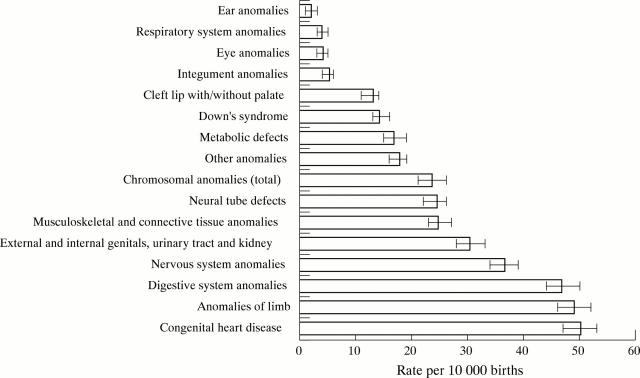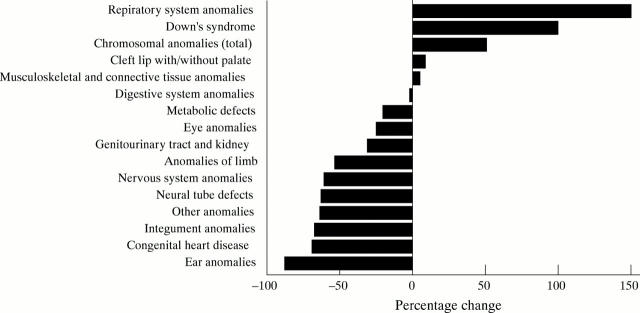Abstract
Aim: To describe the epidemiology of congenital anomalies in Glasgow with special reference to secular trends.
Methods: The prevalence of congenital anomalies was determined retrospectively in 233 777 births using the Glasgow Register of Congenital Anomalies for the period 1980–97.
Results: The total prevalence of congenital anomalies was 324 per 10 000 births, declining by just over a third from 382 per 10 000 births in 1980 to 238 per 10 000 births in 1997. The categories of defects with the highest prevalence were congenital heart disease (50 per 10 000 births), anomalies of limbs (49 per 10 000 births), and digestive system anomalies (47 per 10 000 births). Prevalence in most categories of anomaly declined, including those of the ear (-88%), congenital heart disease (-69%), anomalies of integument (-67%), nervous system anomalies (-61%), anomalies of limb (-54%), and urogenital (including renal) anomalies (-31%). By contrast, there was a significant upward trend for chromosomal anomalies (+50%).
Conclusions: Despite the decline in the prevalence of many types of congenital anomaly, around 2.5% of all births in Glasgow were still associated with these disorders in 1997. In attempting to explain the prevalence and secular trend of congenital anomalies in Glasgow, underlying contributing factors require to be considered. These include changes in case ascertainment, antenatal screening, and diagnostic methods.
Full Text
The Full Text of this article is available as a PDF (129.1 KB).
Figure 1 .
Total prevalence (with 95% CI) of congenital anomalies by year in Glasgow, 1980–97.
Figure 2 .
Prevalence (with 95% CI) of categories of congenital anomalies, Glasgow, 1980–97.
Figure 3 .


Secular trend in prevalence (rates per 10 000 births) for selected groups of congenital anomalies, Glasgow, 1980–97.
Figure 4 .
Percentage change in the prevalance of congenital anomalies from 1980 to 1997, Glasgow.
Selected References
These references are in PubMed. This may not be the complete list of references from this article.
- De Wals P., Trochet C., Pinsonneault L. Prevalence of neural tube defects in the province of Quebec, 1992. Can J Public Health. 1999 Jul-Aug;90(4):237–239. doi: 10.1007/BF03404123. [DOI] [PMC free article] [PubMed] [Google Scholar]
- Eizaguirre-García D., Rodríguez-Andrés C., Watt G. C. Congenital anomalies in Glasgow between 1982 and 1989 and chromium waste. J Public Health Med. 2000 Mar;22(1):54–58. doi: 10.1093/pubmed/22.1.54. [DOI] [PubMed] [Google Scholar]
- Kalter H. Five-decade international trends in the relation of perinatal mortality and congenital malformations: stillbirth and neonatal death compared. Int J Epidemiol. 1991 Mar;20(1):173–179. doi: 10.1093/ije/20.1.173. [DOI] [PubMed] [Google Scholar]
- Kalter H. Folic acid and human malformations: a summary and evaluation. Reprod Toxicol. 2000 Sep-Oct;14(5):463–476. doi: 10.1016/s0890-6238(00)00093-9. [DOI] [PubMed] [Google Scholar]
- Kalter H., Warkany J. Congenital malformations (second of two parts). N Engl J Med. 1983 Mar 3;308(9):491–497. doi: 10.1056/NEJM198303033080904. [DOI] [PubMed] [Google Scholar]
- Kalter H., Warkany J. Medical progress. Congenital malformations: etiologic factors and their role in prevention (first of two parts). N Engl J Med. 1983 Feb 24;308(8):424–431. doi: 10.1056/NEJM198302243080804. [DOI] [PubMed] [Google Scholar]
- Macdonell J. E., Campbell H., Stone D. H. Lead levels in domestic water supplies and neural tube defects in Glasgow. Arch Dis Child. 2000 Jan;82(1):50–53. doi: 10.1136/adc.82.1.50. [DOI] [PMC free article] [PubMed] [Google Scholar]
- Powell-Griner E., Woolbright A. Trends in infant deaths from congenital anomalies: results from England and Wales, Scotland, Sweden and the United States. Int J Epidemiol. 1990 Jun;19(2):391–398. doi: 10.1093/ije/19.2.391. [DOI] [PubMed] [Google Scholar]
- Rosano A., Botto L. D., Botting B., Mastroiacovo P. Infant mortality and congenital anomalies from 1950 to 1994: an international perspective. J Epidemiol Community Health. 2000 Sep;54(9):660–666. doi: 10.1136/jech.54.9.660. [DOI] [PMC free article] [PubMed] [Google Scholar]
- Rosano A., Smithells D., Cacciani L., Botting B., Castilla E., Cornel M., Erickson D., Goujard J., Irgens L., Merlob P. Time trends in neural tube defects prevalence in relation to preventive strategies: an international study. J Epidemiol Community Health. 1999 Oct;53(10):630–635. doi: 10.1136/jech.53.10.630. [DOI] [PMC free article] [PubMed] [Google Scholar]
- Stevenson R. E., Allen W. P., Pai G. S., Best R., Seaver L. H., Dean J., Thompson S. Decline in prevalence of neural tube defects in a high-risk region of the United States. Pediatrics. 2000 Oct;106(4):677–683. doi: 10.1542/peds.106.4.677. [DOI] [PubMed] [Google Scholar]
- Stone D. H. A method for the validation of data in a register. Public Health. 1986 Sep;100(5):316–324. doi: 10.1016/s0033-3506(86)80054-3. [DOI] [PubMed] [Google Scholar]
- Stone D. H., Hamilton F. M. Uses and limitations of registers of congenital malformations: a case-study. Public Health. 1987 May;101(3):191–197. doi: 10.1016/s0033-3506(87)80067-7. [DOI] [PubMed] [Google Scholar]
- Yen I. H., Khoury M. J., Erickson J. D., James L. M., Waters G. D., Berry R. J. The changing epidemiology of neural tube defects. United States, 1968-1989. Am J Dis Child. 1992 Jul;146(7):857–861. doi: 10.1001/archpedi.1992.02160190089028. [DOI] [PubMed] [Google Scholar]





